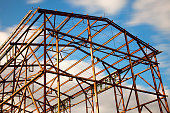Pioneering Large-Scale Frame Innovations for Circles
페이지 정보

본문
The appeal of space frames lies in their ability to create airy spaces that seamlessly integrate into their environments. In arenas, this translates to stunning views of the surrounding scenery, with the audience's gaze directed toward the podium. The integrity of space frames, coupled with their modern aesthetic appeal, makes them an attractive alternative for engineers designing grand amphitheaters.

In recent centuries, space frame innovations have become increasingly popular in theater design, particularly in the outdoor setting. This is because space frames can be designed to adapt to various weather settings and provide shelter from the conditions, such as rain, while maintaining an unobstructed perspective. Additionally, space frames offer a high degree of flexibility, allowing designers to create individual and visually striking buildings that complement the surrounding context.
The planning process for a space frame arena involves several key factors. Firstly, engineers must ensure that the structure meets national building codes and regulations, which can vary significantly depending on factors like weather, wind, and proximal use.
Space frame structures for arenas can take several different forms, but most commonly incorporate a combination of pentagonal and quadrilateral elements. These forms allow for maximum customization, while also providing exceptional strength and resistance capacity. The use of thin materials, such as carbon fiber, can also help reduce the overall dead weight of the building, سازه فولادی making it more suitable for massive buildings.
One notable illustration of a space frame theater is the Australian arts Center's outdoor theater, located in Australia. Completed in 2009, this halls complex features a honeycomb space frame layout with alloy parts and a semi-opaque material roof, providing an impressive 360-degree perspective of the surrounding scenery. The arena is capable of withstanding extreme climatic settings, including gusty rain and heavy rainfall.
Another notable case study is the Austrian capital State ballet's scenic exposed stage, designed by the agency Auer. Completed in 1994, this distinctive structure features a curved space frame layout with a flexible medium roof, providing shelter from the conditions, while also offering breathtaking visions of the nearby cityscape. The innovative creation of this space frame arena has been widely acknowledged for its appeal and strength ingenuity.
In conclusion, space frames are a leading option for amphitheaters due to their adaptability, integrity, and aesthetic beauty. With ongoing advances in components and creation, space frame complexes are becoming increasingly trendy in gargantuan building projects, from amphitheaters to commercial centers and business buildings. As designers continue to push the limits of space frame planning, we can expect to see even more stunning examples of these buildings in the centuries to come.
- 이전글Secure Zones: How Space Frames Enhance Security in Design 25.06.01
- 다음글Lost Files Recovered in WPS: A Step-by-Step Guide 25.06.01
댓글목록
등록된 댓글이 없습니다.

